29 Types of Clocks by Mechanism, Features, & Use [Pictures]
Author: Rick Worst | Editor: Omar Alonso
Review & Research: Jen Worst & Chris Miller

Of all the different types of clocks out there, they've all existed to serve one purpose: to measure time.
Time... You cannot rewind or fast forward it. And that is probably what makes it a great measuring system. Today, everyone has a mobile phone and many of us have got rid of wristwatches because of that (though smart watches are on the rise).
But if you think about it, there is nothing that can replace the grandeur of a nice grandfather clock or the quirkiness of a cuckoo clock on the walls of your home or office. It is a nice touch.
Whether it is to remind you of the time or add more sophistication to your living room, clocks have been in existence for thousands of years now. Beginning from sundials and water clocks to candle clocks and hourglasses, clocks have helped humans to keep a track of time.
From your homes to offices, public places, shops and more, you can find the different types of clocks everywhere. Available in various shapes and sizes, you can also find clocks in computers, mobile phones, as well as in people’s pockets.
Types of Clocks Based on Mechanism
The main way we discuss clocks, and part of how their value is derived, is by their means of movement. Let's look at these first, avoiding the earlier water clocks, hourglasses, sundials, astronomical clocks, incense, oil-lamp, hairspring, and other pre-clock devices.
Atomic Clock
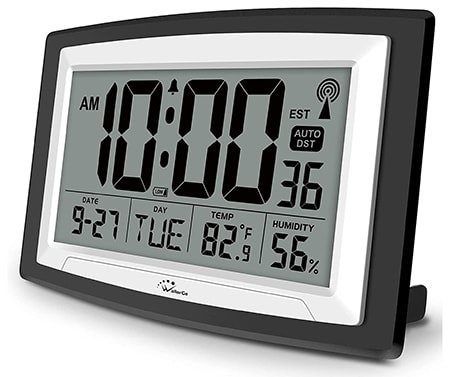
Mostly used by NASA for the GPS satellites that orbit the Earth, atomic clocks are also used in smartphone watches, electrical power grids, and for synchronizing time in GPS.
These clocks can help to measure the frequencies in electrons, electromagnetic atomic transitions, as well as microwaves. They feature perfect stability and can withstand extreme weather conditions.
Atomic clocks, like those pictured above, are for consumers which set themselves based on radio broadcasts from the government, which are themselves based on the official atomic clock.
Electric Clock

These clock types are powered by electricity and are good to use as soon as they are plugged into an electric socket.
Since these clocks require electricity, they can fall behind with time in case of a power outage. Furthermore, they also require resetting once they stop working. Many have a backup battery to stop this problem from occurring though.
Mechanical Clock

These clocks usually have an oscillator that measures the time. While mechanical clocks are less accurate than atomic clocks, they can be used at any time of the day regardless of the weather condition or access to electricity.
Mechanical clocks are widely used in financial markets, GPS, aviation, and television industry and even in numerous scientific studies due to their oscillating mechanism's accuracy, often thanks to a controller to add energy lost to friction.
While these clocks don't look much different from any other, it's their internal mechanisms that are different. Some are designed to show off this fact by having see-through portions where you can see the gears and various types of springs.
Due to the precision required in creating these types of clocks, they tend to be more expensive. They're valued for their craftsmanship, especially in wrist watches.
Quartz Clock
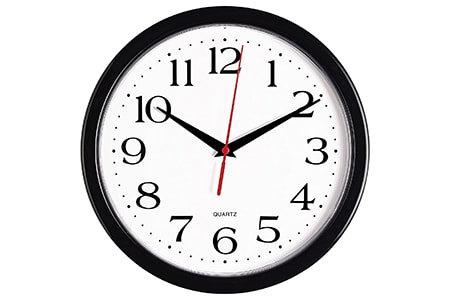
These clocks operate using the electronic rhythm movement of quartz crystals. The crystals vibrate and determine the time when they experience an electric charge from the small battery.
One of the best parts about a quartz clock is that it is extremely stable and accurate. It's hard to beat out the physics of quartz crystal oscillations, except with atomic clocks. They're really inexpensive, too.
Pendulum Clock

These are one of the most famous types of clocks used around the world. Invented in the 1600s, pendulum clocks have been consistently used not just in homes and offices but also in numerous public places.
Pendulum clocks have wide pointers which keep it stable and in order. Furthermore, these clocks take advantage of the force of gravity in order to function properly. Their freestanding form makes them a visual attraction.
Spring-Driven Clock

These are no longer used due to their inability to keep a constant rate of movement since the spring would start to wind down and require winding. They were among the earliest attempts, and some collectors do still use these to this day.
They're fun in sense that they are more interactive. People prefer them in wrist watches and alarm clocks in the present, where every once in a while you give the spring mechanism another winding twist to keep it going.
Types of Clocks Based on Features
The different kinds of clocks above all work fine in their modern forms. What we really tend to care about are the features they have, when it comes to our daily lives. Let's look at these clock styles.
What you'll notice is the clock names perfectly describe their features, which is nice so it's not confusing or too hoity-toity.
Analog Clocks

Amongst the most popular types of clocks, analog clocks typically have numbers on the outside of the device's face. Additionally, these clocks also consist of the hour and minute hands to show the time.
These clocks are mostly used in offices, educational institutions, and different public places rather than homes. Some will feature the date or even the daytime and nighttime cycle. Their use of minute hands and even a second hand make them perfect for measuring short periods of time.
Battery-Powered Clocks

These clocks are great to use if you experience a lot of power cuts. All this kind of a clock requires is a timely replacement of battery. You can also disconnect and reconnect this clock when you move from one place to another.
Electrical clocks have begun including batteries as a backup source of power so the time is always held accurately even if the power goes out. Ones with batteries only are great for outdoors trips like camping.
These are used in alarm clocks very often in order to not have to reset them when the power goes out, which is why you see some like the one above with red lighting (or green or blue) so as to not be too bright on your eyes at night or in the morning.
Digital Clock
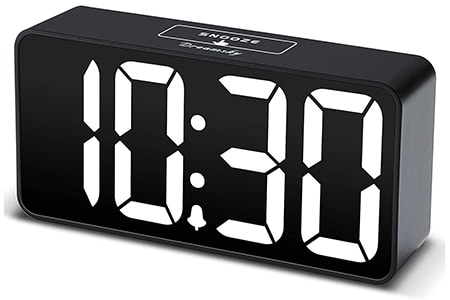
These are the easiest clocks to read the time. From children to adults, anyone can read time on digital clocks due to their display of numbers instead of radial dials.
Digital clocks also function as great alarm clocks. Additionally, some digital clocks are designed in a way that they can glow in the dark, thereby reducing the need to get up from your bed to check the time. They make nice nightlights for children, too.
Radio Clock

One of the more modern forms of a clock, radio clocks are great for people who want to capture two birds with one stone. Here, that means checking the time and listening to music or the radio.
You can also place this clock near your bed or on your desk. Moreover, some radio clocks also consist of humidity and temperature displays. Quite fancy!
The best part is the antenna and radio receiver can even turn on music to function as the alarm instead of a jolting buzzing or beeping sound, so we can wake up peacefully.
Calendar Clock
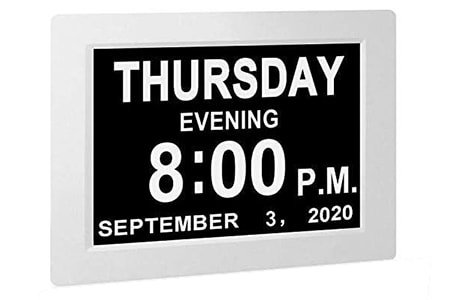
Just like radio clocks, calendar clocks are modern devices that can also tell you the date along with the time. These are also quite popular in workplaces, offices, and schools. They don't often include the month, just the day and date number.
Multi-Display Clock

The main purpose of these clocks is to display the time in the various time zones, the date, and the temperature. These clocks are usually great for people who travel to different places.
You'll see these in airports by the dozens, near the terminals and eateries. They're common in stock trading facilities, internet and information technology centers, and other places that work with people all around the world.
Electronic Word Clock

This is a fascinating clock variety that doesn't have a numeric display but has sentences on the screen that tell the time. These sentences can be recorded using the appropriate hardware or through specific software.
Some can be made to share other messages than just the time, too, but that's starting to get away from the purpose of a time piece altogether.
Auditory Clock

These clocks use human or computer-generated voices to tell time. Modern smartwatches fall in this category. In these clock types, time can also be presented as an auditory code and is often used in large areas to announce the time. Church bells are an example of this.
For the blind, these are very useful. They often operate as simple, large buttons you press that then reads the time out loud, like the one pictured above. These are often called "talking clocks"
Tactile Braille Clock

Tactile braille clocks are also an example of auditory clocks. These are meant particularly to help people with imperfect vision. These are basically clocks that produce the physical representation of time on the surface.
It means the user with an imperfect vision can feel the hands of the clock to tell the time. The clock could also have a blind text code (braille) for the same end result.
Time Zone Clock

Time zone clocks are designed for travelers and business people to be able to tell the time all around the globe. Usually in cities in which they conduct business, versus every single time zone.
They can be analog or digital and can accommodate different time zones because they have multiple faces. Some people have trouble reading analog, circular clocks still.
Musical Clock
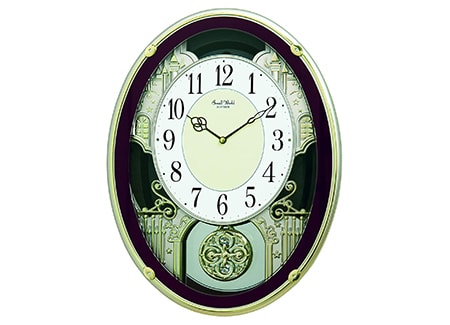
As the clock names describe, these will play a melody on the hour, every hour, and perhaps a different tune upon midnight or noon. They can often be programmed as alarm clocks that play music instead of beeping and chirping at the prescribed time.
Light Sensor, Sunrise, & Chime Shutoff Clocks

Having a fancy clock in your home, such as a grandfather clock or cuckoo clock is great, except when they start making very loud noises in the middle of the night.
A light sensor clock knows when the lights are out and will mute themselves from chiming on the hour, as will a chime shutoff clock. You can program them, for example, to be muted during the hours between 9 PM and 8 AM.
Other light up, sunrise clocks will begin to emit a light at gradually brighter intensities to slowly wake you up when it's time instead of blaring an alarm sound, vibration, or music.
Types of Clocks Based on Use & Popularity
Now that we've covered the various kinds of clocks based on their mechanisms and features, lets look at them based on how they're used and where we use them.
Wall Clock

These clocks are undoubtedly some of the most widely used clocks in homes as well as offices. In addition to telling the time, these clocks can be hung on the walls as decor, like with bedroom feng shui.
You can even find these clocks in public areas, for easy access to people. Available in different shapes and sizes, some wall clocks are also considered to be novelty items.
Outdoor Clock

For people who have their own restaurant, store, or another business and want to add value to the exteriors of their premises, an outdoor clock made of some metal is a great addition. The main feature is they're dust and water-proof.
In addition to being quite functional and attractive, these clocks also help passers by to check the time quickly. Place it near the name of your business to get people looking at both. Some people also hang an outdoor clock in their garden or whatever types of patios they have for a more rustic look.
Mantel Clock

Also known as shelf clocks, mantel clocks are spring-driven clocks that are usually placed on top of the mantel above a fireplace. However, they can be placed on any other types of shelves or surfaces as well.
Mantel clocks usually have a metal or wooden exterior and can also replace decorative items on the mantel. You'll see these in fancy business offices to enhance the decor.
Tabletop Clock

These are clocks placed on all types of tables and mantels. They are a bit more private when compared to wall clocks and can be decorative items but that is not necessarily always the case. These types of clocks are smaller and are still mostly useful for everyone in the room.
They come in an amazing variety of designs and styles to match the decor of the room precisely because of their private nature. The most popular ones take after classic designs that fit into any office situation.
Projection Clock

These clocks are usually digital in nature and consist of a projector that is used to display the time on a surface or in the air. Projection clocks can be hung on walls or ceilings and are great for people who have trouble with their vision.
Furthermore, most projection clocks are powered by electricity, although some also consist of batteries for backup power. Some have waving wands that blink in such a way to display the time suspended in the air.
Grandfather Clock

If you are in search of a huge clock, the grandfather clock is your best bet. In addition to being the most traditional and largest types of clocks in the world, grandfather clocks also consist of a pendulum mechanism.
These clocks also enhance the appearance of a home and give it a rustic appeal. You can find many different designs and sizes of such clocks at vintage or antique stores around the globe.
They stand on the ground themselves and reach very high, often above 6 to 7 feet in height. They're often very ornamental and become heirlooms. They're also extremely expensive.
Cuckoo Clock

Commonly found in homes, cuckoo clocks have rather unique features that attract people towards them. This includes the appearance of a cuckoo bird every time the dial strikes an hour.
These little birds will come out of the clock on a track, do a little dance, and chirp a few times before receding back into the clock face. Cuckoo clocks also have small Roman numerals that are marked in their dials.
Roman Numeral Clock

These clocks can come in any type or style. The key difference is that they use Roman numerals instead of Arabic numerals around the dial. It simply adds a little sophistication to the face.
Alarm Clock
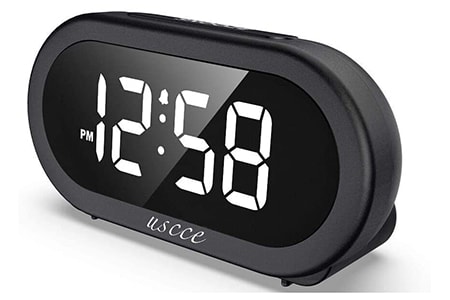
Quite possibly the most widely used types of clocks, alarm clocks have been designed in a way that it can alert you at a specified time set by you. They also tend to have different alert functions like light, sound, or vibration.
Maritime, Weather Station, or Marine Clock

These nautical clocks (sometimes called chronometers), although not used frequently in homes or offices, tend to serve different purposes. These clocks can help you monitor the humidity and weather conditions in addition to telling the time. They are perfect for use in boats, ships, and in homes of those who love the sea.
They're a great addition to your decor to help make your living room cozy. People can read and discuss the humidity and barometric pressures, read the temperature on a thermometer, and more.
Floor Clock

A floor clock is simply that, one that has legs and is situated on the floor. That doesn't mean they're low to the ground, because the legs will be tall enough to elevate them to be read in a seated position usually. They look very much like various types of floor lamps and eat up as much floor space.
A Quick History of Clocks
Dating back to as early as the 1300's, clocks are possibly some of the oldest inventions made by man. It was during this time when the first mechanical device to measure time was invented in Europe.
The story of clocks began with the most basic types of sundials which were used to determine the direction of the sun and subsequently tell us about the time. It consisted of a vertical stick made of metal and fixed on a horizontal surface.
This surface was typically marked with the words morning, noon, afternoon, evening, and night and helped to mark the time of the day by measuring the length and position of the shadows. Although this method wasn’t quite accurate, it did help mankind for almost 2,000 years.
With technological advancements, humans began to invent clocks that helped to determine the time more accurately. By the mid 1650's, pendulum clocks were invented and they went on to become some of the most precise time measuring devices in the world.
These were followed by the grandfather clock in the early 1700's and the cuckoo clock towards the later half of 1700. Finally, it was in 1840 when the first electric clock was invented which gave way to the wrist watch and portable clock around 1929.
The Final Hour: Types of Clocks for All Personalities
Are you on the lookout for a versatile, beautiful, and functional clock? And while buying, are you confused as to which one you should choose? This confusion can happen, more so considering the numerous types of clocks available in the market.
However, all you need to do is decide on your preferences and what features you require in a clock, along with the shapes and sizes that are best suited to your needs.
All clock styles have a different usage, cater to different needs and fulfill a different purpose. So dig deeper into our list of the different types of clocks and choose one that checks all your boxes!
You'll Also Enjoy:
- 16 Candle Alternatives That Still Provide Relaxing Scents & Great Light
- 43 Types of Marble With Unique Features That Can Impress Anyone
- 12 Types of Tile: All the Different Varieties to Choose From
- 11 Types of Bathroom Sinks for You to Wash Up in Style
- 20 Types of Light Switches: Toggles, Dimmers, & More



